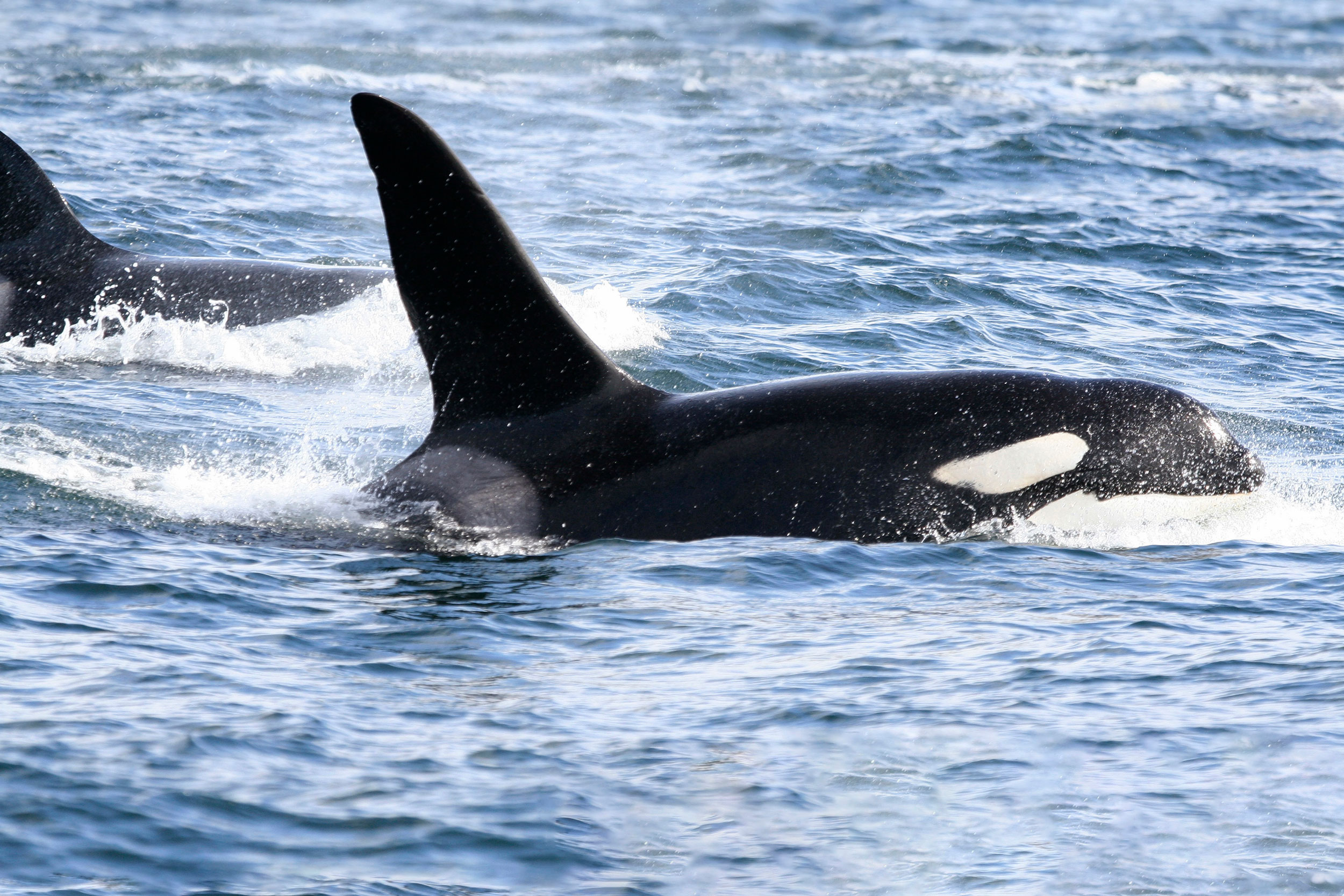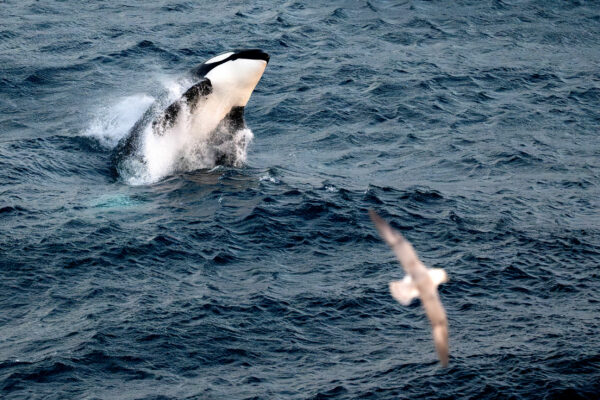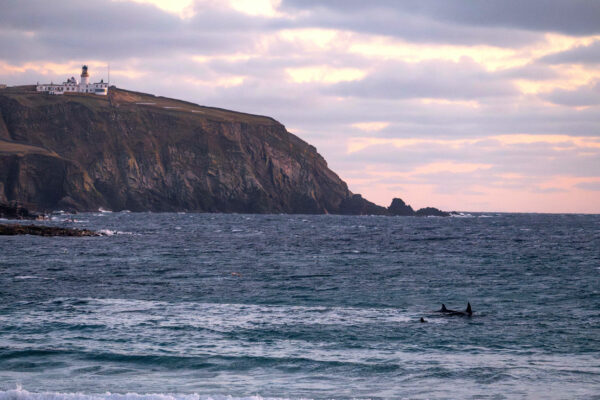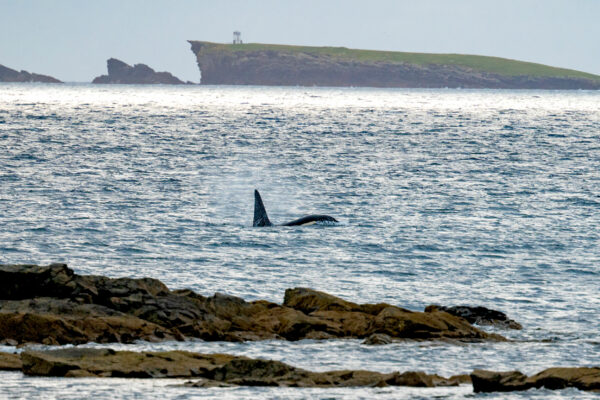Orcas (Killer Whales) are among some of the UK’s most incredible wildlife. Intelligent, beautiful, gigantic carnivores with their own social structures, language and culture. Seeing an Orca, even just the dorsal fin scything through the waves, is thrilling. Watching these magnificent animals hunt even more so. In this article, I’ll be taking a look at two areas where you may be able to enjoy watching Orcas.
The West Coast Community
On the West coast of Scotland, the future is looking bleak for a once thriving pod. The only animals thought to remain are two males, Aquarius and John Coe. John Coe was first recorded as an adult in 1980, making him at least 60 years old. This is at the upper end of a male Orca’s lifespan. Females can live a lot longer, up to 90 years, with one North American animal, Granny, reported as reaching the age of 105.
There were once 10 identified individual Orcas in the West Coast Community, a pod which is thought to have been much larger in the past. Most of these animals are now either missing, having not been seen for eight years, or in the case of one individual, confirmed to have died. As the pod never produced any calves during the three decades they’ve been monitored, there have been no new offspring to replace them.
This pod is physically distinct from other Orcas found in the North East Atlantic and UK waters. They’re about a metre longer, and have a distinctive eye patch which slopes downwards rather than horizontal. Their teeth are also different to other Orcas here, less worn down due to their preference to hunt other cetaceans – the collective term for whales, dolphins and porpoises.
The Hebridean Whale & Dolphin Trust have been monitoring cetaceans in this area since the early 1990s. The Trust’s Director, Alison Lomax, explains that this pod is thought to be socially distinct too, and has never been seen interacting with other pods of Orcas in UK waters since monitoring began. Recent research published in 2021, led by Dr Andy Foote, has also revealed that the West Coast Community are a severely inbred population, likely inbreeding over several generations, which can affect fertility.
One of the females, Lulu, was sadly found dead, stranded on a beach in Tiree in January 2016. She’d been entangled in rope. When a post-mortem was carried out, scientists found that she had one of the highest levels of polychlorinated biphenyl (PCB) pollution in her body ever recorded in Orcas. This may indicate another reason why the pod hadn’t produced any young, as high PCB level is linked to infertility as well as poor health, an impaired immune system and increased risk of cancers.
PCBs were used in many different materials, such as electrical appliances, over a long period of time before being banned in the UK in 1981. Because Orcas are at the top of the food web, the accumulation of these chemicals builds up in them, as the insecticide DDT did with birds of prey in the UK before its ban in 1986.
Tragically, the much-loved West Coast Community of Orca face extinction within our lifetime. Inbreeding and the social isolation of the pod, coupled with the high levels of PCB toxicity and threats such as entanglement from our increasingly busy seas are all factors that are leading this group to extinction.
Aquarius and John Coe are wide ranging, and sightings are unpredictable, but they can be seen at any time of year in the waters around the Isle of Mull. And if you are visiting the Hebrides and are lucky enough to see these two recognisable Orcas or other whales and dolphins, you can help with a little citizen science. Report your sightings through the Whale Track website or free smartphone app.
Orcas surfacing close to the shore. Video: The RSPB
The Northern Isles community
There are now three main Orca pods which make up the Northern Isles community: the 64s, the 65s (a recent ‘split’ from the 64s) and the 27s, each led by a matriarch whose ‘names’ (the numbers) give the pods their name.
The 27s, along with other Orcas, featured in the spectacular BBC TV series Wild Isles, which the RSPB co-produced. Silverback Films Producer Nick Gates says, “We just missed the 27s in our first year filming, as they left on the very day we arrived! The next year the team returned and captured some extraordinary footage of them hunting!”
These pods can typically be seen in Shetland, Orkney, Caithness, the Western Isles, and the North East of Scotland. They feed mainly on Harbour Porpoises and both Grey and Harbour Seals. Sometimes birds such as Black Guillemots, Eiders, and even moulting Greylag Geese are taken, though this type of hunting is more social than of calorific value. They are assumed to be relatively healthy pods which regularly produce calves. But there are risks to these animals here too: a five-year-old Orca calf from the 27s pod may have died in an entanglement incident off Orkney in 2021 – though this was never proved.
In addition to the West Coast Community and the Northern Isles Community, three or four pods of migratory Icelandic Orcas spend the spring, summer and autumn months around the coast of Scotland. Here they feed on marine mammals before returning north to feed on fish during the winter months. Photo identification collaboration between Scottish and Icelandic researchers has revealed this migration to be annual.
There is also a large offshore population which is presumably resident and may number several hundred individuals. Very little is known about these individuals which often associate with the offshore pelagic fishing industry.
You have a chance of seeing Orcas at any time of year in Scottish waters. You can spend hours looking at an empty ocean, so it’s sometimes best to wait for a reported sighting to come in via social media then be ready to go and look for the pods. Then, try to get ahead of the pod’s direction of travel as they rarely change course once on a particular trajectory.
Holly Paget-Brown, Biosecurity for Scotland Officer at RSPB Scotland, says that there’s a very active community of experts and enthusiasts who record sightings and put together guides including an actual Scottish catalogue of Orcas, allowing people to identify individuals. The photo identification catalogue is a free resource and you can download it here: Scottish Killer Whale Photo Identification Catalogue.
“We also have a very active citizen science community that primarily works around Facebook and WhatsApp, sharing sightings,” adds Holly. “I’ve seen the Orcas dozens of times and it’s all been thanks to other people’s reports.”
Sightings can be reported via the following Facebook groups: Shetland Orca Sightings, Orkney Cetacean Group, Caithness & Moray Firth Cetacean Sightings, and Hebrides and NW Scotland Cetacean Sightings. Visitors are encouraged to adhere to the Scottish Marine Mammal Watching Code at all times – viewing the animals considerately, following the Scottish Outdoor Access Code, and not blocking roads when pulling vehicles over to watch Orcas.
“People think we haven’t got the ‘good stuff’ like lions and tigers, but it’s just incredible that they can come here and have an absolute top-shelf wildlife encounter,” says Stephanie Cope, RSPB Scotland Conservation Officer.
Many of these Orcas are easily seen from land. For example, RSPB Sumburgh Head is a great place to look for the pods, along with Minke Whales, dolphins and a variety of seabirds including Puffins and Fulmars.
With thanks to the Hebridean Whale and Dolphin Trust, Hugh Harrop and Karen Hall from the Scottish Killer Whale Group, Nick Gates, and Dr Andy Foote.






